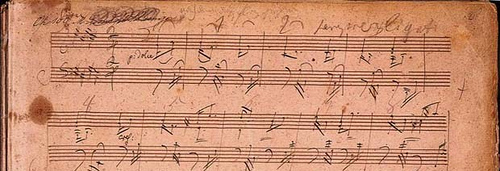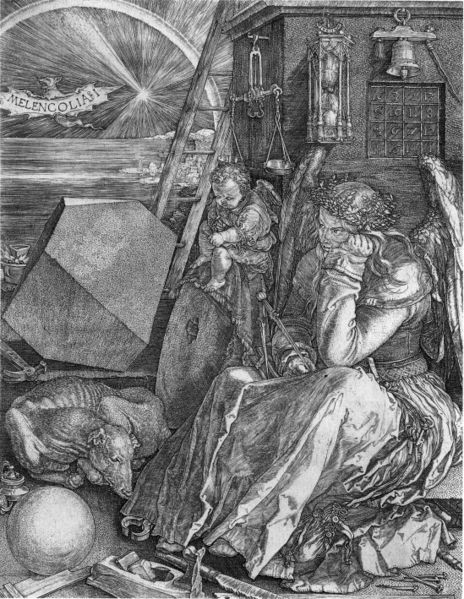“Skill without imagination is craftsmanship and gives us many useful objects such as wickerwork picnic baskets. Imagination without skill gives us modern art.” — Tom Stoppard
Art
Occupational Handicaps

Monet lost his vision, but not his hearing.
Beethoven lost his hearing, but not his vision.

Finding the Holy Grail

There’s no chalice on the table in Leonardo’s Last Supper …
… but there is one on Bartholemew’s head (far left).
Fallow and Fertile


Albrecht Dürer’s Melencolia I might brood about thwarted creativity, but it contains one of the most brilliant magic squares in all of European art.
You can reach the sum of 34 by adding the numbers in any row, column, diagonal, or quadrant; the four center squares; the four corner squares; the four numbers clockwise from the corners; or the four counterclockwise.
As a bonus, the two numbers in the middle of the bottom row give the date of the engraving: 1514.
Smile

In 1911, Argentine con man Eduardo de Valfierno found a way to steal the Mona Lisa six times over at no risk to himself.
First he made private deals with six separate buyers to steal and deliver the priceless painting. Then he hired a professional art restorer to make six fakes, and shipped them in advance to the buyers’ locales (to avoid later trouble with customs).
In August he paid a thief to steal the original from the Louvre, and when news of the theft had spread he delivered the six fakes to their recipients, exacting a high price for each. Then he quietly disappeared. The flummoxed thief was soon caught trying to sell the red-hot original, and it was returned to the museum in 1913.
05/27/2020 UPDATE: This is false but extraordinarily widely retailed. The painting was stolen in 1911 by an Italian criminal named Vincenzo Peruggia, but the original was recovered and returned to the Louvre two years later. There is no evidence that Valfierno ever existed, and none of the six supposed copies has ever surfaced. The myth was conceived by a writer named Karl Decker and retailed as fact in a 1932 issue of the Saturday Evening Post, which was still havering equivocally as to its falsity as recently as 2013.
A Well-Timed Exit
Composer Arnold Schoenberg was fascinated with numerology. Born on Sept. 13, he came to fear that he would die at age 76, because its digits add to 13. He examined a calendar for 1951 and was dismayed to see that July 13 fell on a Friday. When the fateful day came he took to his bed, fearing the worst. The day passed uneventfully, and shortly before midnight his wife entered the bedroom to say goodnight. Schoenberg uttered the word “harmony” and died.
The time of his death was 11:47 p.m., 13 minutes before midnight on Friday, July 13, in his 76th year.
It Has a Good Beat, You Can Dance to It

Hungarian composer György Ligeti’s Poème Symphonique for 100 Metronomes calls for fivescore clacking timepieces to be set up across the stage, wound fully, and set to different speeds. Once they’re all going, the performers leave, the audience enters, and everyone watches them run down.
This takes 20 minutes. “It is up to the conductor to decide the duration of the pause, before he leads the players back on to the stage to receive the thanks due from the public.”
La Fornarina

When Raphael died in 1520, a portrait was found in his studio of a local baker’s daughter named Margherita. She is thought to have been his lover — on his deathbead he had bid her farewell and arranged for her care.
The portrait might reveal something else as well. Writing in The Lancet in 2002, Georgetown University medical professor Carlos Hugo Espinel suggests that “La Fornarina” might have had breast cancer:
There is a bulge in the [left] breast that, beginning inward from the axilla and curving horizontally to the right, slopes gently toward the nipple. This bulge seems to be a mass, oval in shape, puckering just above the tip of La Fornarina’s index finger.
After studying other artworks, Espinel has also concluded that Michelangelo had gout, that Rembrandt died of temporal arteritis, and that the Mona Lisa’s smile may have resulted from the partial paralysis of a facial muscle. Independent research has supported some of these diagnoses.
Showoff

Eyewitness account of a performance by the 8-year-old Mozart, 1769:
“After this he played a difficult lesson, which he had finished a day or two before: his execution was amazing, considering that his little fingers could scarcely reach a fifth on the harpsichord.
“His astonishing readiness, however, did not arise merely from great practice; he had a thorough knowledge of the fundamental principles of composition, as, upon producing a treble, he immediately wrote a base under it, which, when tried, had a very good effect.
“He was also a great master of modulation, and his transitions from one key to another were excessively natural and judicious; he practiced in this manner for a considerable time with an handkerchief over the keys of the harpsichord.
“The facts which I have been mentioning I was myself an eye witness of; to which I must add, that I have been informed by two or three able musicians, when Bach the celebrated composer had begun a fugue and left off abruptly, that little Mozart had immediately taken it up, and worked it after a most masterly manner.
He was still an 8-year-old, though. “For example, whilst he was playing to me, a favourite cat came in, upon which he immediately left his harpsichord, nor could we bring him back for a considerable time.”
(From Daines Barrington, “Account of a Very Remarkable Young Musician,” Philosophical Transactions)
Curse of the Ninth
Anton Bruckner died after writing his ninth symphony. So did Beethoven, Schubert, and Dvořák. In the 19th century, a superstition arose that a quick death awaited anyone who wrote nine symphonies.
Arnold Schoenberg wrote: “It seems that the ninth is a limit. He who wants to go beyond it must pass away. It seems as if something might be imparted to us in the Tenth which we ought not yet to know, for which we are not ready. Those who have written a Ninth stood too close to the hereafter.”
Mahler figured he could escape the curse with a decoy: When he finished his ninth, he retitled it “The Song of the Earth” and wrote a second “ninth” symphony. When nothing happened, he told his wife “the danger is past,” started a new work — and died.
